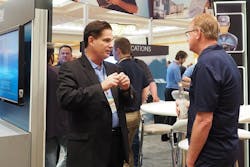With all the sensors, controllers and technology already in place in trucks, an additional device many fleets are considering is a video capture product. Fleet professionals learned that during beta testing of PeopleNet's forthcoming truck video system, only a single collision was captured. But it proved significant: the video likely saved a truck driver's career from taking a hit, and showed that the driver — and by extension that company — were not at fault in the crash.
The presentations were at PeopleNet's recent User Conference in Phoenix. Audience members had to look closely to catch what happened on the subject truck's video, which came from a forward-facing camera mounted inside the cab near the top and middle of the windshield. But playing the footage back slower and frame-by-frame, what happened could be seen plainly in one of the truck's rearview mirrors.
The truck is traveling along on a stretch of two-lane highway with no other vehicles in sight. A car approaches quickly from the rear in the adjoining lane, closing in on the truck, then drifts toward the road's shoulder away from the truck — perhaps also running into a rumble strip — and overcompensates in a jerk back onto the road, ultimately overshooting its lane and hitting the side of the truck. Throughout the incident, the truck never strays from its lane and tracks straight ahead.
"I got a phone call from the driver; driver's very upset," a representative from the company recalled, noting that the other party typically denies responsibility. "The first thing [the other driver] always says is, 'Your truck drifted into my lane.'"
The passenger car, as it collided with the side of the truck, "tore off the step and also impacted the [diesel exhaust fluid] tank, the air tank and the fuel tank," the representative noted. The passenger car was damaged at the front and rear ends of the side that hit the truck.
The incident might've had a different outcome if the phone call and perhaps photos from the accident scene were all the company had to go on. As it turned out, that particular truck driver happened to have been in a few accidents when the collision occurred, and another could've had an impact on the driver's career.
"So first of all, [the video] may have saved the driver's job," the representative said. "And secondly, if they wanted to file a suit against us, I had conclusive evidence we weren't doing anything wrong and our driver did everything right."
Why video?
Jim Angel, PeopleNet's vice president for video intelligence solutions, discussed the functionality of the company's video product at the conference and explained why he believes fleets should consider adding video to their trucks. In the battle for hearts and minds, it appears the trucking industry has the deck somewhat stacked against it.
Angel said there's a media bias against the trucking industry that's an important consideration, touching on an op-ed piece that'd just been published by The New York Times, "The trucks are killing us." "Part of the battle we fight is because of the media representation of trucking in general," he contended, "and what's been told to the American public about what we do and what our truck drivers do, which is absolutely false.
"In fact, if we could legitimately send a message to the good old U.S. of A., you shut our trucks down for about three days and everybody would realize what a catastrophe we'd have on our hands when all their stuff didn't get delivered and they can't go to the grocery shelf and get their Cheerios or their Froot Loops — or for that matter, anything else," he continued.
There's also a sort of little guy-big guy perception of passenger car collisions with heavy trucks, Angel suggested, that can manifest in court such that the burden is often on the trucking company to exonerate itself after an accident, despite evidence and trends to the contrary. He cited a body of both U.S. and European research over time showing that in passenger car collisions with commercial vehicles resulting in a fatality, the passenger car is at fault around 70% or more of the time.
To help illustrate the point, Angel showed a video captured in October 2014 (see below) from a truck traveling in Belgium on European Route E 40 between Bruges and Ghent. In the video, which he cautioned the audience is "pretty severe," an accident occurs directly in front of the truck and there's nowhere to go but to crash into the already-damaged passenger car.
Angel then took it a step further: a truck simply being there when a collision occurs can lead to a lawsuit. "We're starting to hear stories of, 'Hey, the fact that your truck was rolled over on the highway and my car hit it, it was your fault the truck was there,'" he said. "That's the kind of lawsuit we're seeing that's being brought forth to carriers."
"Any video solution is worth considering, and if you aren't, you ought to," Angel asserted. "Without video evidence, the odds [in court] are unlikely to be in favor of the trucking company. But the odds are in your favor if you have the right tools to show when your driver is not at fault."
Other features of PeopleNet's in-truck video system such as driver coaching, he said, "are gravy," and the main benefit is being able to show the truth of a collision given that perception and opinion may be against your company. "All the other features are wonderful, like being able to coach a driver on a risky behavior or an event that you capture. But your ROI with video comes from the ability to prove that 75% of the time [with passenger car-commercial vehicle fatality collisions] when you're not at fault."
The big debate: Driver-facing cam
In the discussions of video systems and accident reconstruction, one point kept coming up and made for some dicey debate: Should a carrier look to put a camera on the truck driver in a video system?
"That's sort of the question of the day, right, the driver-facing camera?" said Mike Nalepka, general manager for video intelligence at PeopleNet. "We've done a lot of talking and a lot of discussion with our customers about this."
Nalepka explained that from those discussions, the company found a majority of its customers are not interested in a driver-facing video camera, but some 10-20% of them "are all in with it." Another group of customers is so far undecided, he pointed out: "Probably about 30% of fleets have told us, 'We really don't know what we're going to do; we might want to use a camera in the cab for training or for our [red-flagged] drivers.'"
For its part, at least for now, PeopleNet has decided against including a driver-facing camera as a feature of its video product, Angel said. "Our approach is we want to look out for the driver — we don't want to look at the driver," he told listeners.
He noted, however, that PeopleNet's video system will be able to accommodate multiple camera feeds, so it can support other placements such as left-facing, right-facing or rear-facing cameras. "If for some reason at your company you feel like that driver-facing camera is important, we'd be able to support it," Angel conceded. "But I think there's some serious conversation that you can have before you approach that.
"The version I like to use is, 'Let the data defend what your driver did, and let the forward-facing [camera] defend what happened in the collision,'" he continued. "We'll tell you how much the driver's foot was on the accelerator; we'll tell you when he engaged the brakes."
An audience member pressed the point, however, noting that a driver-facing camera is "a question that comes up everywhere" and asking Angel for his opinion on the matter. Angel noted that a driver-facing camera, should its video show "that perfect driver with his hands at 10 and 2" on the wheel, indeed could be of use in an accident lawsuit.
But there's another side to it: truck drivers are a road-tough bunch, covering long miles and often slogging through mud and all kinds of adverse conditions in doing their jobs. When it comes to it, they may not look much different than your stereotypical biker, for instance, and that may not play well with a jury.
"I've talked to some legal representation that's said they had a case where it was clearly not [the truck driver's] fault, but when they showed the driver-facing part of the video — with a guy with the Harley-Davidson t-shirt, the big beard, the bandana around his head, the three earrings in his ear — where automatically the jury went directly to an opinion or a perception of somebody that looked mean.
"But yet, they weren't doing anything wrong," Angel said. "So my opinion is, again, let the data do the talking for what your driver was doing, and let the video do the talking for what happened" outside the truck.
In addition, he noted, adding a driver-facing camera in a truck likely won't build much trust between driver and employer. "The forward-facing camera is readily accepted by the driver. It's not hard to tell your drivers, 'We're looking for your protection, but we're not interested in what you're doing,'" Angel contended. But a driver-facing camera doesn't carry the same connotations, he added.
"You hired them because they're professionals, and now you want to flip a camera on them and look at them all the time? It's your choice, but you need to look at and understand how they may feel about it," Angel advised.




